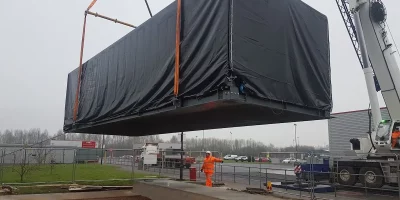It is no secret that data centres are aging. So often, a data centre’s infrastructure becomes outdated, leaving it susceptible to security threats and unable to support the latest applications and services. Fortunately, there are ways to make old data centres modern and secure again.
Modern software technology heavily relies on data centres, critical in expanding enterprises’ capabilities. In contrast to error-prone paper-and-pencil documentation methods used in the past, data centres have significantly improved data usability. Data centres have allowed businesses to accomplish more while using less physical space and time to manage data. However, upcoming innovations in data centre technology will significantly change how data centres are designed and used.
The Data Centre: Past, Present, and Future
The conventional data centre, called a “siloed” data centre, heavily depends on hardware and physical servers. It is characterised by the physical infrastructure, which serves a singular purpose and defines the data storage and handling capacity of the data centre. Moreover, traditional data centres are limited by the physical space where the data centre hardware is located.x
The amount of storage in a server or modular data centre is limited by its physical space. In addition, adding more storage requires more hardware, making it harder to maintain cooling in the same area. Because of this, traditional data centres have many physical limitations.
The initial computers closely resembled the standard data centres we use today. However, the dot-com era of the late 1990s and early 2000s led to the proliferation of siloed data centres, which continue to be utilised today.
Physical storage is necessary due to the fast rise in their numbers to accommodate the extensive data needed for websites and applications to run in the user’s browser.
Early data centres were considered reliable and provided satisfactory performance when first introduced. However, they were slow and inefficient in delivering services and had meager utilisation rates than their total capacity. Traditional data centres also take a long time to deploy new applications, sometimes taking months for an enterprise to accomplish this task.
What are the 3 types of data centres that exist today?
Although data centres come in different sizes, ranging from small server rooms to large groups of buildings in other locations, they all serve as crucial business assets that companies are typically equipped with the latest data centre networking, computing, and storage technologies.
The traditional data centre has changed from an on-premises facility to a hybrid infrastructure that connects on-premises systems with virtualised networks, applications, and workloads in various public and private clouds.
Colocation
A colocation centre, sometimes called a “carrier hotel,” is a data centre where you can lease resources such as equipment, space, and bandwidth from the data centre space’s proprietor.
Instead of renting a virtual machine, you can rent a certain amount of hardware directly from specified data centres instead of using a public cloud provider.
Enterprise
An enterprise data centre is a company-owned data centre that processes internal data and hosts essential applications.
Cloud
To create a virtual data centre in the cloud, you can utilise third-party cloud services that offer various features instead of only renting hardware and configuring it on your own, similar to colocation.
Five data centre upgrade strategies to modernise your facility
Renovating a data centre can help organisations extend their working life without incurring high costs. Upgrades can improve existing facilities and infrastructure, adopt new standards, and introduce more efficient technologies that offer better performance.
Improve consolidation and efficiency by upgrading servers and systems.
The primary energy consumers in a data centre are servers, particularly their processors and memory components. To improve energy efficiency, organisations can upgrade their servers to more efficient models during planned technology updates when they already have a budget.
Consider modifying the system and rack layouts to improve power and cooling efficiency.
Please closely examine the arrangement of your equipment’s existing power distribution unit in the data centre and identify ways to enhance the efficiency of power usage and cooling.
Imagine you had a data centre with a large CRAC unit cooling the room. After reducing the number of servers by 75% through a server refresh and consolidation project, it may be possible to rearrange the remaining servers in fewer racks and use containment to enclose them.
This reduces the amount of mechanical cooling required by limiting the air volume that needs to be cooled and enables the use of alternative cooling technologies.
One suggestion is to explore additional or different cooling methods.
Although mechanical HVAC systems are commonly used in modern data centres, they come with high costs and energy consumption. In addition, they can pose a risk as a single point of failure in ensuring the data centre equipment’s availability. For example, a data centre can overheat rapidly in a cooling system failure.
Data centre renovations often aim to improve cooling by adding or replacing traditional mechanical equipment with alternative methods. These methods include higher operating temperatures, better containment, and fewer pieces of equipment.
Addressing potential issues ensures that power distribution systems are available and reliable.
To ensure uninterrupted business operations, it is essential to consider the capacity and availability of backup power equipment for telecommunications data centre equipment and centres.
Replacing the old model with a new one for UPS systems can enhance energy efficiency for data centre upgrades and provide better power monitoring for data centre infrastructure management.
Limitations of the Current Data Centre Environment
Managing a data centre infrastructure can be a demanding job that requires constant attention. However, your stakeholders expect uninterrupted service, even if it seems unachievable.
As a System Admin, you might feel like you’re constantly putting out fires as you juggle responsibilities like backups, security, resource management, and equipment replacements. However, developing a plan can help alleviate some of the stress and pressure of your job.
Infrastructure and Capacity Planning
One of the significant challenges faced by data centres is related to the physical space. Inadequate space, excess space, or high temperatures caused by hardware proximity have substantial and long-lasting impacts on data centre availability. Therefore, it is crucial to carefully plan the physical infrastructure of data centres.
Too Much Space After Equipment Refresh
When combining old and new servers, planners need to consider that even though new servers are smaller and take up less space, they use more power due to their higher energy consumption. Additionally, virtual and physical servers’ requirements may impact your facility’s needs.
Power and Uninterruptible Power Supply (UPS) Failure
One primary reason for unplanned outages is power failures and the failure of uninterruptible power supplies. This is often due to inadequate planning and insufficient investment in UPS equipment.
Data Centre Environmental Issues
Data centres and their servers require power for operation and thermal management, leading to high energy consumption. Therefore, it is crucial to identify the energy sources for the existing data centre to meet their energy demands.
Challenges in Data Centre Networking and Cabling
There are two challenges that data centre networking might encounter. The first challenge concerns bandwidth, the amount of data that can be transferred over a connection. A higher bandwidth leads to a quicker network speed.
The bottom line
Data centres need to be well-maintained and managed. Understanding your data centre footprint, equipment requirements, available energy sources, and the facility’s layout is essential to keep it efficient and running smoothly. This includes monitoring power systems, cooling systems, networking capabilities, and cable plans.
By addressing these issues, data centres can become more reliable and secure and reduce energy consumption. This helps maintain operational costs and improve performance. Furthermore, investing in the latest technologies is essential for staying up-to-date with industry standards and emerging business services, which can help ensure uninterrupted business operations.






